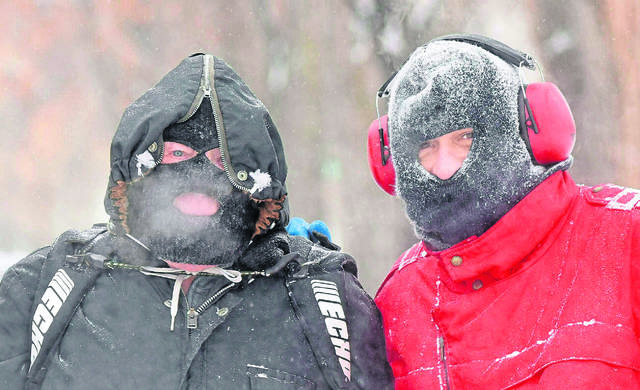Extreme cold calls for precautions indoors and out
The arctic blast predicted for this week, with wind chills well below zero, will not be fit for man nor beast — nor exterior wall plumbing.
Emergency room doctors and veterinarians alike are urging residents to stay indoors with their pets and limit time outside to no more than 15 minutes on Wednesday and Thursday, when temperatures will dip into the single digits with wind chills below zero.
•••
People
It only takes five to 10 minutes for frost “nip” to set in on exposed skin when wind chills hit minus-10 degrees or colder, according to Brent Rau, an emergency physician at Allegheny General Hospital.
“Anytime you are outside, all of your skin needs to be covered in such severe cold,” he said. “Fifteen minutes outside is the max.”
The very young and the elderly, particularly the homeless elderly, are most at risk during severe cold snaps such as the one forecasted this week.
Since the elderly have a tougher time regulating their body temperature, they are at greater risk of hypothermia, which begins with shivering, elevated blood pressure and confusion, Rau said.
Frost nip, which graduates to frost bite, starts when skin discolors and then becomes painful, and can further develop into blisters, he said.
•••
Pets
Animal Protectors of Allegheny Valley in New Kensington receives more calls about pets and strays in the cold weather, according to Gwen Snyder, shelter manager.
“When it’s going to be cold like this, only let them outside to do their business,” Snyder advised. “Don’t leave pets outside untended.”
The state law forbids pets from being tethered outdoors for more than 30 minutes when the temperatures dip below 32 degrees. If residents see a pet left outside in the cold beyond 30 minutes, they should alert their local police department or local humane agent, Snyder said.
Additionally, dogs can hurt their paws on the ice and salt. Pet owners should wipe their dogs’ paws when they return indoors to prevent problems.
Cats should stay indoors during cold snaps, Snyder added.
•••
Plumbing
Plumbing in older homes in exterior walls can easily freeze overnight with temperatures forecast for this week.
Jim Miller, owner of E.H. Miller Plumbing Co. in Plum, has seen frozen pipes again and again in super cold weather. He advises residents in older homes, especially in ones with plumbing in exterior walls and with pointing issues to:
• Shut off the water to the outside hose faucets so they don’t freeze.
• Let cold and hot water lines drip to keep water moving in the lines. “Either pipe can freeze,” Miller said. Open the cabinet doors where there is plumbing to let warm air in.
• Don’t turn down the temperature in your house when you leave to go to work. “You can do that when it’s 40 to 30 degrees,” he said. “But don’t try to save $3 on your gas when frozen pipes could cost you thousands in repairs.” Ideally, you want your home warmer than 62 degrees. Miller sets his thermostat at 72 degrees and higher.
Night time is when lines typically freeze, he said.
Mary Ann Thomas is a Tribune-Review staff writer. You can contact Mary Ann at 724-226-4691, mthomas@tribweb.com or via Twitter @MaThomas_Trib.
Remove the ads from your TribLIVE reading experience but still support the journalists who create the content with TribLIVE Ad-Free.

